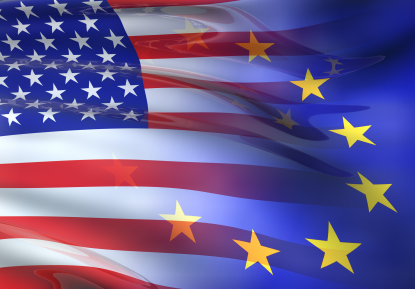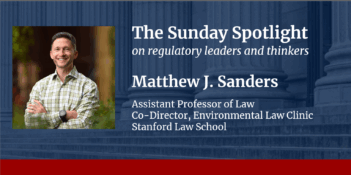
PPR seminar speaker argues that Europe has become a global leader in regulation, US more restrained.
The United States and Europe have swapped regulatory philosophies, according to David Vogel, professor of business and political science at the University of California, Berkeley, who spoke at the University of Pennsylvania recently as part of the Penn Program on Regulation’s risk regulation seminar series.
Vogel argued that prior to 1990, the United States regulated health, safety, and environmental risks caused by businesses far more stringently than Europe did. After 1990, however, the United States has regulated far less aggressively than has the European Union.
Vogel illustrated his thesis by reminding the audience of the late 1970s when the threat of ozone depletion garnered the attention of citizens on both sides of the Atlantic. The United States’ regulatory system responded by banning all non-essential CFCs, chemicals believed to cause the destruction of the ozone layer. Most European governments decided not to act, citing a lack of evidence linking CFCs and ozone damage.
About fifteen years later, a similar potential threat arose in both the United States and Europe: genetically modified organisms. Notwithstanding concerns about the health and safety risks of GMO in foods, the United States decided to stay its regulatory hand because the evidence did not prove GMOs were dangerous to human health, said Vogel. The European Union, however, decided to err on the side of caution and began to regulate the field aggressively. Today, 90-95% of American processed foods have GMO ingredients whereas only 5% of European processed foods contain them, Vogel contended.
The changes in regulatory policy present in these two examples, according to Vogel, are demonstrative of the overall trend. In the span of just one decade the United States and Europe have traded regulatory philosophies. While the United States formerly regulated new threats aggressively, it now hesitates more before action; and while Europe previously avoided issuing new regulations, it now reacts quickly to potential threats.
Professor Vogel posited that the shift in regulatory philosophy on both sides of the Atlantic can be attributed to three major sources: changes in public opinion, preferences of policy elites, and the administrative and legal criteria for assessing risk.
First, since 1990 Americans have been satisfied with their government’s efforts to protect health and safety, said Vogel. He cited surveys indicating that Americans are happy with the level of government regulation but do not desire additional regulations. Europeans, however, seem particularly sensitive to risks and therefore are supportive of more stringent regulations of new threats. Vogel hypothesized that this support of precautionary regulations may have grown after the outbreak of mad cow disease, which plausibly convinced citizens that their government was not adequately assessing risks and issuing proper regulations.
Second, the preferences of policy elites changed in both the United States and Europe around 1990, according to Vogel. He placed the change in the American posture squarely in the hands of the Republican Party, which he believes has shifted drastically to the right. “People have forgotten that regulation in these fields used to be bipartisan,” Vogel reminded the seminar’s attendees. “In fact, some of the largest regulatory increases occurred during the Republican administrations of Nixon and H.W. Bush.” Yet over the past two decades, Republicans have become increasingly critical of government regulation, Vogel said.
By contrast, European policy elites have grown increasingly supportive of regulation during the same period. According to Vogel, as the European Union grew in size, it felt increasing pressure from its individual member states not to undermine the protections of their individual regulatory schemes. Acceding to this demand, the European Union began adopting the regulatory standards of the most stringent member states, thereby increasing the regulatory demands of all of its members.
Finally, Professor Vogel argued that the different approaches the European Union and the United States take to risk assessment has lead to diverging views of the proper role of regulation. In the United States, administrative agencies now must support their decisions with carefully reasoned arguments that take into account the costs and benefits of proposed regulations. This method, according to Vogel, is focused on protecting the public from unnecessary and burdensome regulations.
In Europe, by contrast, regulators do not need to assess risk as vigorously as their American counterparts, Vogel said. Rather, European regulators have adopted the “precautionary principle,” the basic thrust of which, according to Vogel, is that government can regulate actions if it can make a merely plausible argument that the actions cause harm. The European method, therefore, is primarily focused on protecting public heath, even if that effort bans certain products that, in truth, are harmless.
Vogel noted that the impact of the trans-Atlantic shift in regulatory posture has been dramatic. While the United States used to set the standard for regulations around the world, the rest of the world now looks to Europe. According to Vogel, Europe has been the “chief demander” of every major environmental agreement since the early 1990s, and businesses—eager to gain access to the European market, which now has twice as many consumers as the American market—have adopted European standards in their manufacturing.
Vogel stressed that his analysis only focuses on business-created risks involving health, safety, and the environment. His argument therefore does not cover regulations regarding the war on terror, communicable diseases, or financial systems—fields in which, according to Vogel, the United States has occasionally been more aggressive than the European Union.



